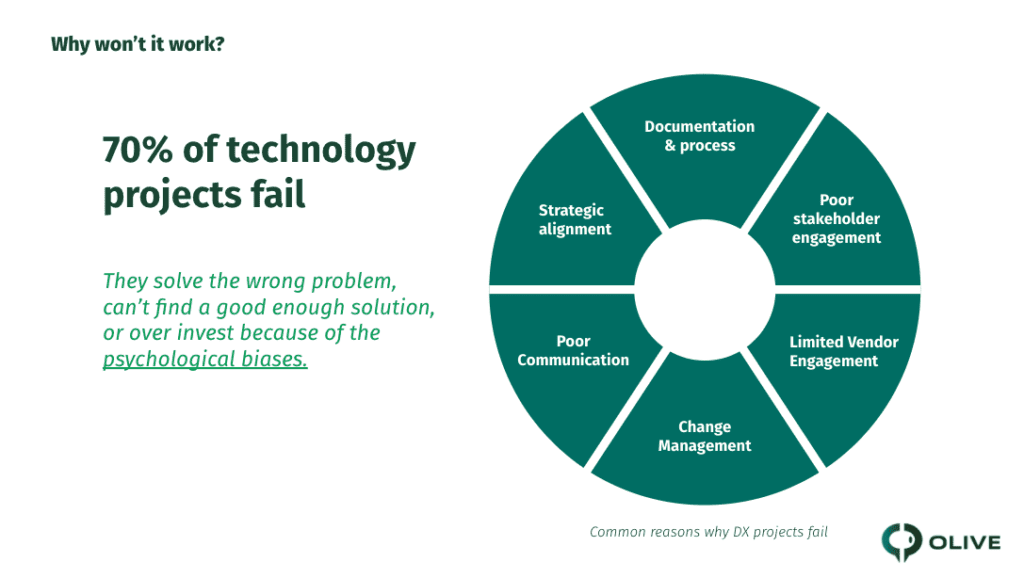1. Agile Collaboration with the Right Stakeholders Will Help You Find the Solutions That Drive Digital Transformation
Digital Transformation Is Not Just about Tech;
It’s about Engaging the Right Stakeholders to Find the Right Tech. You’re probably sick of hearing that the top priority of C-suite executives for 2023 is the acceleration of digital transformation. No one is surprised that revenues for the most agile and digitally advanced companies thrived through the pandemic while most others plummeted. But digital transformation has been a priority for the last few years. $4.5 trillion has been spent on digital transformation since 2017, so why wasn’t everyone equally prepared during the pandemic?

Source: Statista, IDC; Statista estimates; Salesforce.com
70% of large-scale digital transformations don’t achieve what they set out to achieve. In essence, they fail, and they fail for remarkably common reasons. CIOs, digital transformation leaders, and IT departments are in such a rush to digitally transform that they skim over the vital parts of the process.

Finding and procuring new technology is not the problem. The problem is solving your business’s challenges as part of a holistic strategy and doing so with the right input. Successful digital transformations happen with plenty of buy-in from those who will be using the solution. It cannot happen in silos. Successful digital transformation requires agile collaboration.
How to Bring Agile Collaboration to Your Digital Transformation
An Agile, Collaborative Solution Evaluation Process Should Be Part of Your Strategy.
There is a common thread of naivety that courses through transforming companies. The belief is that you need the new and shiny software that has brought your competitors an edge, and you need it now. There is some truth to that thought. There are huge competitive advantages to be gained through digital transformation, but not when disjointed, disorganized, sloppy, or lazy. The phrase “Nobody ever got fired for buying IBM.” just highlights the lack of effort that has been put into strategy thus far.
Digital transformation should involve key stakeholders and be a well-thought-out strategy with a clear business objective to solve and a clear path to success
- What are you trying to achieve?
- What does success look like?
- What challenges are you trying to solve?
- What is driving the change?
You need to ask your stakeholders these questions to figure out the unique requirements your business has.
Not having a collaborative strategy with specific goals leads to a host of problems:
- Buying expensive software that doesn’t integrate with your tech stack.
- The team doesn’t like it, so doesn’t end up using it.
- Different teams use different tools for the same thing.
- A specific need for transformation was not heard.
- Solving symptoms of a problem rather than the problem itself.
- You buy software that solves the wrong problem.
Take time to create a direction for your company and articulate how the digital transformation serves your vision. Perhaps you need to cut costs, change your business’s direction, adapt to your consumers’ new behaviors, boost productivity, or relieve bottlenecks caused by legacy software. The point is, your process of transformation should have an overarching business goal, identified in collaboration with your stakeholders.
2. High Stakeholder Engagement, Plus an Agile, Streamlined Process, Results in High User Adoption
When creating your strategy or considering software solutions, you need to think about who the stakeholders are. They could be employees, consultants, leadership, customers, or suppliers. They are the beneficiaries, direct and indirect users, local authorities, board members, and decision-makers impacted by the strategies and software introduced.
Make a list of the key stakeholders and how you will avoid diluting the most critical voices. Who needs to be heard?
3. Identify the Right Stakeholders to Collaborate with on Your Digital Transformation
Collaborating with the right stakeholders solves multiple problems and eases transitions like;
- Solving the right problems.
- Articulating must-have features from software.
- Prioritizing the software requirements.
- Avoid short-sighted solutions and missed requirements.
- Critically evaluating the needs of the business and capabilities of the software.
- Understanding the compatibility with your current tech stack.
- Grasping the ROI or TCO of your solution.
- Getting the buy-in of your team.
- Improving practices for all stakeholders.
- Achieving your business aims.
The most important thing to remember is that the stakeholders impacted, hold the key to your digital transformation success. They should be involved at all levels from defining the problem to delving deep into the specific requirements and implementation.
4. Collaborate with Stakeholders to Determine the Business Case and Requirements
Let’s be real, the process can be painstaking, excruciating and old-school. It involves heavy-duty due diligence to get to the bottom of the problem and to gather requirements. There will be countless conversations, healthy arguments, and debates. For those collecting the info, it’s a nightmare, but for those who share and are heard, it’s therapy.
To learn the business processes and the need to install a new digital solution, you need to conduct:
- Internal efficiency and cost analysis
- Round table discussions
- Employee surveys
- One to one Interviews
- Job shadow
Each of these activities informs your decisions but also involves listening to the stakeholder. The more valued and respected they feel, the more invested they will be in the eventual implementation. You don’t always have to do what they ask, but listen to their concerns, and explain if possible why you go in the direction you go in. Even if they don’t get exactly what they need, this will show them you are listening and have to listen to their needs in the context of the wider business. The more implementation champions you have, the smoother the process.
5. Don’t Neglect Change Management and Implementation
The ease of your implementation is based on how involved the key stakeholders were but also how prepared you are. Never underestimate the resistance nor the fear of change.
Employees will be concerned about the possibility of software, AI, or machine learning replacing them. Reassure where possible. If redundancies are a possibility, consider letting them know early so they can prepare. If not, tell them and reiterate their importance to the process. Being transparent about these challenges and helping your end user understand from a business perspective why the change is happening, only increases their buy-in, and trust in the solution.
The smoothness of implementation is utterly crucial. Have a change management plan ready to go. Of course, it will need to focus on software training but it should also be sympathetic to the personal needs of the end user. People fear technology, and the one-click disasters like deleting essential files and correspondence. Make every effort to deal with the change on a holistic level.
3 Ways to Increase the Trust Factor Towards Digital Transformation
Mitigating Digital Transformation Risks and Costs
The traditional process requires thorough due diligence and careful planning. It involves choosing a dedicated digital transformation leader and hearing from, potentially, 100s of stakeholders. Beyond the people involved it costs time and money , and comes with considerable risks.
The risks can also be hidden. For example, when most search for the next best software, they will almost always go to market evaluation platforms like Gartner, G2, and Capterra but these have an ingrained bias. Vendors pay to feature meaning when you search these sites, you only get the options they are paid to show you. There is no guarantee the results are based on the best fit to your needs.
The market might have a ton of perfect-fit solutions but there’s a high chance you won’t see those if you only go with limited sites.
Olive’s Digital Transformation Platform and Services Streamline Your Digital Transformation
Digital transformation is a slow burner and can be nightmarish for many. The rush to improve performance and stop the competition from taking market share leads to rash decision-making devoid of stakeholder input. It doesn’t have to.
Using a centralized and accessible tool like Olive streamlines digital transformation. It allows you to run the entire process collaboratively in far less time, so you can dig into those juicy and important conversations that matter to your stakeholders, and develop a deeper understanding. This is listening!
At Olive, we start with that, building an understanding of your overarching goals, pain points, goals, and objectives and recording them in one place to share with your team. This ensures that every step is guided by what you and your stakeholders need, and nothing else.
Once the aims and pain points are clear, we set you up to engage the right stakeholders and collaborators. We provide you with surveys and tools to hear from your teams and ask the right questions. Using our platform means you can gather their requirements easily with little to no fuss. Olive even provides you with a library of requirements to peruse to make sure you haven’t missed anything. With the requirements gathered, stakeholders are invited to rank the needs in terms of importance.
Whilst stakeholders are contributing and ranking requirements, our system invites vendors to engage and respond to your needs. We gather the responses, community insights, and more to assign a best-fit rating based on exactly how well the vendor meets your requirements.
From there, you can create a shortlist of who is the most suited and set up a demo. We can even provide you with a list of questions to consider asking.
Olive is here to provide you with the best-fit solution and smoothest digital transformation possible.





